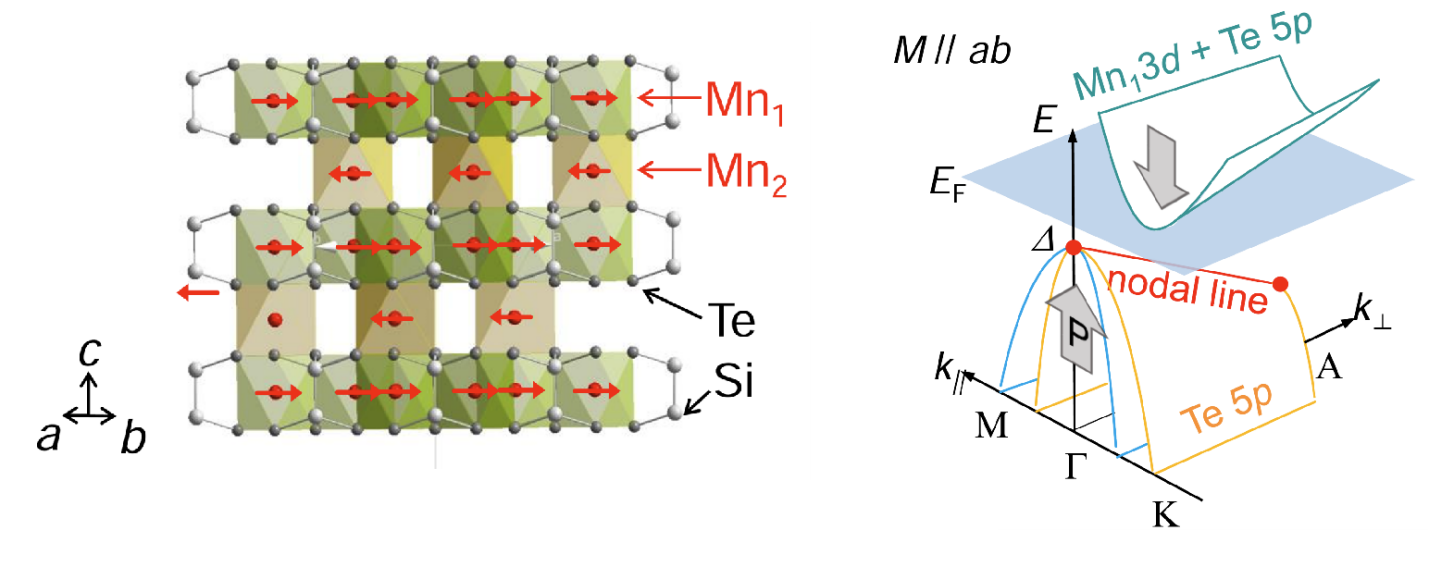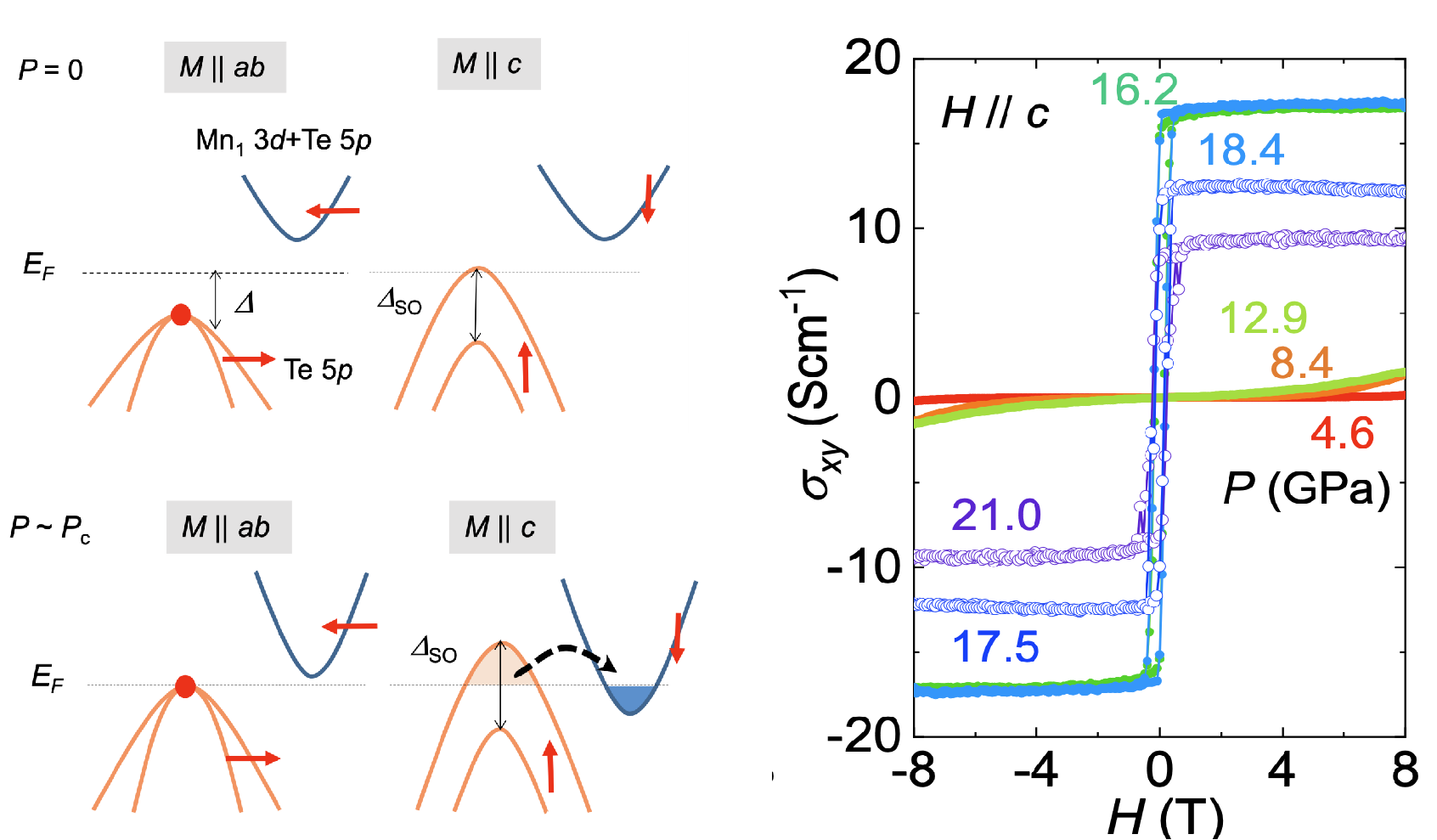
For controlling the spin properties of a topological magnetic semiconductor, a novel material with topological electronic states and magnetism, a new approach has been proposed. A research team led by Professor Jun Sung Kim from POSTECH and Professor Keehoon Kim from Seoul National University, collaborated with computational group led dy Dr. Duck Young Kim from HPSTAR, has observed a spin reorientation phase transition in the topological magnetic semiconductor Mn3Si2Te6 by adjusting its topological electronic state. This study was recently published in Nature Communications.
Topological magnets are new class of materials where the quantum mechanical wave of electronic states manifests topological characteristics, potentially serving as source materials for spintronic devices. In topological magnetic semiconductors, electromagnetic properties are expected to be determined solely by their topological electronic states, possibly revealing new properties not found in conventional materials. However, experimental studies directly linking topological electronic states and spin properties were rare due to the scarcity of candidate materials.
In 2021, the research team first reported that the electrical resistance of Mn3Si2Te6 changes by a factor of one billion depending on the spin direction. In this study, they applied external pressure to Mn3Si2Te6, inducing a semiconductor-metal transition by altering its topological electronic state. During this transition, an anomalous Hall effect, originating from the topological electronic state, increased sharply, and the spin alignment direction changed abruptly from planar to perpendicular. This indicates that the strong spin-orbit coupling of the topological electronic state alters the spin alignment. This is the first direct observation of spin state changes through topological electronic state control.
Research on topological magnets is highly competitive globally and leads the development of spintronic device technology. This study is significant as it presents the first experimental verification of the principle behind the unique spin property changes in topological magnets. Professor Jun Sung Kim, co-corresponding author, stated, "This research is expected to serve as an important foundation for understanding the relationship between topological electronic states and electromagnetic properties of topological magnetic semiconductors and for applying this understanding to spintronic technology." Dr. Duck Young Kim also stated “This study is an important outcome of collaborative high-pressure research between China and Korea. We are currently conducting joint research on various two-dimensional topological materials.”

Caption: The manganese silicon telluride compound (Mn3Si2Te6), identified as a topological magnet, has a unique structure where manganese atoms (Mn2, red) are intercalated between layers composed of tellurium (Te, gray) and manganese atoms (Mn1, red) (left). The semiconductor Mn3Si2Te6 forms a Te 5p valence band with a nodal line located 0.15 eV below the Fermi level (right).

Caption: The diagram illustrates how the nodal line in the topological magnetic semiconductor Mn3Si2Te6 rises under pressure and, as it crosses the Fermi level, the spin reorientation opens a gap (left). This topological phenomenon, occurring when the nodal line gap opens at the Fermi level, results in an anomalous Hall effect (right).
拓扑磁性半导体是一类兼具拓扑电子态和磁性的新型材料,其电子态的量子力学波具有拓扑特性,是自旋电子器件的理想材料。在这种材料中,电磁性质仅由其拓扑电子态决定,并可能揭示许多传统材料中未发现的新属性。然而,由于候选材料的稀缺,直接将拓扑电子态和自旋特性联系起来的实验研究很少。最近,由POSTECH的Jun Sung Kim教授和首尔大学的Keehoon Kim教授领导的研究团队,与由北京高压科学研究中心的理论计算小组,Duck Young Kim课题组合作,提出了一种压力控制拓扑磁性半导体的自旋特性的方法。他们对Mn3Si2Te6施加压力,通过改变其拓扑电子态诱导了半导体-金属转变,在这个转变过程中,源自拓扑电子态的反常霍尔效应急剧增加,自旋排列方向从平面突然变为垂直,这表明拓扑电子态的强自旋轨道耦合改变了自旋排列。这是首次通过拓扑电子态的控制直接观察到自旋状态的变化。这项研究最近发表于《自然-通讯》上。